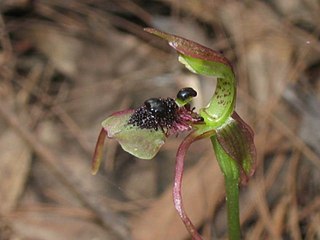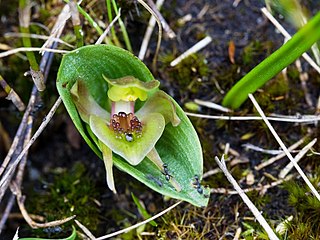Genoplesium validum, commonly known as the Blackdown midge orchid, is a small terrestrial orchid endemic to the Blackdown Tableland National Park in Queensland. It has a single thin leaf fused to the flowering stem and up to thirty five greenish-brown flowers with reddish stripes and a hairy labellum.
Chiloglottis anaticeps, commonly known as the duck's-head wasp orchid or bird orchid is a species of orchid endemic to the New England Tableland of New South Wales. It has two narrow leaves and a single greenish brown or reddish flower with a shiny, dark green callus occupying most of the top of the labellum. One end of the callus looks like a tiny duck's head.
Chiloglottis chlorantha, commonly known as the Wollongong bird orchid, is a species of orchid endemic to a small part of New South Wales. It has two broad leaves and a single green to yellowish green flower with about twelve reddish, yellowish or bright green glands on the labellum callus.

Chiloglottis diphylla, commonly known as the common wasp orchid, is a species of orchid endemic to Australia. It has two broad leaves and a single narrow, greenish brown to reddish flower with a black, insect-like callus covering the upper surface of the labellum.

Chiloglottis formicifera, commonly known as the common ant orchid, is a species of orchid endemic to New South Wales. It has two broad leaves and a single narrow, greenish or reddish flower with a black, ant-like callus covering most of the upper surface of the labellum. There is a single record of this species from New Zealand.

Chiloglottis jeanesii, commonly known as the mountain bird orchid, is a species of orchid endemic to Victoria. It has two broad leaves and a single green to dark purplish brown flower with shiny black, column-like calli on the labellum.
Chiloglottis longiclavata, commonly known as the northern wasp orchid, is a species of orchid endemic to Queensland. It has two leaves and a single narrow, pinkish green flower with a dark blackish red callus covering most of the upper surface of the labellum.
Chiloglottis × pescottiana, commonly known as the bronze bird orchid, is a species of orchid endemic to south-eastern Australia. It has two broad leaves and a single greenish bronze or purplish brown flower with a black, ant-like callus on the labellum. It is a natural hybrid formed from a cross between Chiloglottis valida and C. trapeziformis.

Chiloglottis platyptera, commonly known as the winged ant orchid or Barrington Tops ant orchid, is a species of orchid endemic to the New England Tableland of New South Wales. It has two broad leaves and a single greenish brown flower with a callus of many glands covering most of the top of the labellum.

Chiloglottis reflexa, commonly known as the short-clubbed wasp orchid, is a species of orchid endemic to the south-eastern Australia. It has two broad leaves and a single greenish-bronze or purplish flower with an ant-like callus covering most of the top of the labellum.

Chiloglottis seminuda, commonly known as the turtle orchid, is a species of orchid endemic to south-eastern New South Wales. It has two broad leaves and a single green or reddish pink flower with a shiny black insect-like callus covering two-thirds of the base of the labellum but with the tip of the labellum free of callus.
Chiloglottis sphaerula is a species of orchid endemic to a small part of New South Wales. It has two dark green leaves and a single green to reddish pink flower with a shiny black insect-like callus covering two-thirds of the base of the labellum but with the tip of the labellum free of callus.
Chiloglottis sphyrnoides, commonly known as the forest wasp orchid, is a species of orchid endemic to north-eastern New South Wales and south-eastern Queensland. It has two dark green leaves and a single green or reddish pink flower with a shiny black, insect-like callus surrounded by red club-shaped calli on two-thirds of the base of the labellum.

Chiloglottis triceratops, commonly known as the three-horned bird orchid, is a species of orchid endemic to Tasmania. It has two broad leaves and a greenish brown to purplish brown flower with a few column-like calli near the mid-line of the labellum.

Chiloglottis trilabra, commonly known as the long-clubbed wasp orchid, is a species of orchid endemic to south-eastern Australia. It has two dark green leaves and a single greenish brown or pinkish flower with a dark red to black, ant-like callus covering most of the upper surface of the labellum. It is similar to both C. seminuda and C. reflexa.
Chiloglottis trullata, commonly known as the triangular orchid, is a species of orchid endemic to Queensland. It has two dark green leaves and a single small, green or pinkish flower with a shiny, dark reddish black, insect-like callus surrounded by reddish club-shaped calli covering most of the upper surface of the labellum.

Chiloglottis turfosa, commonly known as the bog bird orchid, is a species of orchid endemic to southern New South Wales and the Australian Capital Territory. It has two dark green leaves and a single greenish to reddish brown flower with a shiny dark reddish callus of mostly thin, column-like glands on the labellum.

Chiloglottis valida, commonly known as the large bird orchid or common bird orchid, is a species of orchid endemic to south-eastern Australia.It has two dark green leaves and a single greenish purple to purplish brown flower with six to ten blackish, column-like calli on the labellum.
Arthrochilus oreophilus, commonly known as montane elbow orchid, is a flowering plant in the orchid family (Orchidaceae) and is endemic to higher places in far north Queensland. It has a rosette of leaves at its base and up to fifteen green, insect-like flowers with dark reddish brown glands on its labellum.
Arthrochilus prolixus, commonly known as wispy elbow orchid, is a flowering plant in the orchid family (Orchidaceae) and is endemic to eastern Australia. It has a rosette of bluish green leaves at its base and up to twenty two pale green, insect-like flowers with dark reddish to purplish glands on its labellum.









